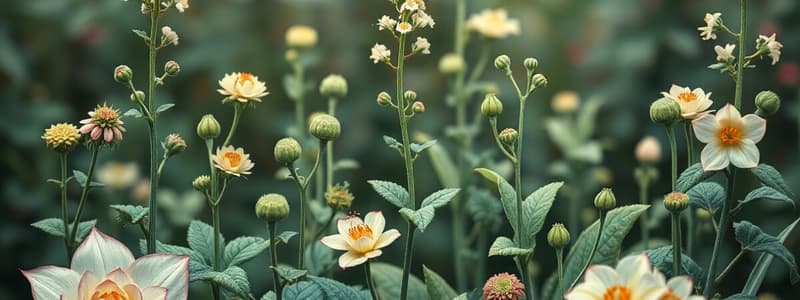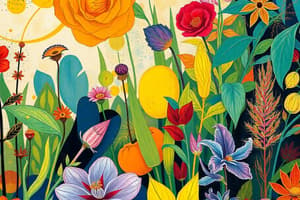Podcast
Questions and Answers
What is one of the methods for obtaining medicinal plants mentioned in the content?
What is one of the methods for obtaining medicinal plants mentioned in the content?
- Fermentation through traditional methods
- Isolation of active compounds
- Cultivation using organic pesticides
- Collection from wild plants (correct)
Which of the following is NOT a step in the cultivation process of medicinal plants?
Which of the following is NOT a step in the cultivation process of medicinal plants?
- Harvesting
- Drying
- Packing
- Fermentation (correct)
What factor does NOT affect the growth of medicinal plants?
What factor does NOT affect the growth of medicinal plants?
- Soil contents
- Water
- Presence of wildlife (correct)
- Temperature
Which plant hormone is primarily responsible for increasing stem length?
Which plant hormone is primarily responsible for increasing stem length?
Which benefit is associated with the cultivation of medicinal plants compared to collection from the wild?
Which benefit is associated with the cultivation of medicinal plants compared to collection from the wild?
What is the primary role of gibberellins in plant growth?
What is the primary role of gibberellins in plant growth?
What is one key advantage of using controlled cultivation compared to wild collection?
What is one key advantage of using controlled cultivation compared to wild collection?
Which growth factor is classified as a growth regulator?
Which growth factor is classified as a growth regulator?
What is the primary purpose of curing vanilla pods?
What is the primary purpose of curing vanilla pods?
Why is careful drying of crude drugs essential?
Why is careful drying of crude drugs essential?
What is the significance of maintaining a low temperature during the drying process?
What is the significance of maintaining a low temperature during the drying process?
Which factor is NOT listed as important in the drying process of crude drugs?
Which factor is NOT listed as important in the drying process of crude drugs?
What changes occur in vanilla pods after curing?
What changes occur in vanilla pods after curing?
What factor does not affect the active constituents of a plant?
What factor does not affect the active constituents of a plant?
When should cloves be collected for maximum quality?
When should cloves be collected for maximum quality?
Which organ of the plant is associated with the highest alkaloid content when collected in the morning?
Which organ of the plant is associated with the highest alkaloid content when collected in the morning?
What is the ideal condition for collecting tea leaves to ensure the best quality?
What is the ideal condition for collecting tea leaves to ensure the best quality?
During which season are colchicum corms rich in alkaloids?
During which season are colchicum corms rich in alkaloids?
Why should leaves, flowers, and fruits be collected in dry weather?
Why should leaves, flowers, and fruits be collected in dry weather?
What aspect of a plant does the stage of maturity most significantly affect?
What aspect of a plant does the stage of maturity most significantly affect?
What is the best time to collect flowers for optimal quality?
What is the best time to collect flowers for optimal quality?
What is the primary reason for collecting bark in spring or early summer?
What is the primary reason for collecting bark in spring or early summer?
When should underground organs be ideally collected?
When should underground organs be ideally collected?
What is the main purpose of decortication in drug preparation?
What is the main purpose of decortication in drug preparation?
Why is bleaching used in the preparation of certain drugs?
Why is bleaching used in the preparation of certain drugs?
What is the cleaning process for underground organs primarily aimed at?
What is the cleaning process for underground organs primarily aimed at?
What process involves inducing desirable changes in the drug through enzymatic action?
What process involves inducing desirable changes in the drug through enzymatic action?
Which step is NOT included in the preparation of drugs before drying?
Which step is NOT included in the preparation of drugs before drying?
What is the consequence of collecting unorganized drugs during dry weather?
What is the consequence of collecting unorganized drugs during dry weather?
Flashcards are hidden until you start studying
Study Notes
Sources of Medicinal Plants
- Wild plants are a source.
- Cultivated plants, including ginseng, ginkgo, and peppermint, are another source.
- Fermentation, using recombinant DNA technology or genetically engineered drugs, is also a source.
- Cell-culture techniques and microbial transformation are other sources.
Cultivation of Medicinal Plants
- Wild plants are difficult to transport.
- Wild plants are prone to eradication by natural events.
- Cultivated plants offer a reliable and consistent supply.
- Cultivation allows control of purity and prevents contamination.
- Trained workers ensure proper harvesting and processing.
Factors Affecting Plant Growth
- Environmental factors, including water, light, temperature, and altitude, influence growth.
- Soil composition plays a crucial role.
- Growth regulators like auxins, gibberellins, and cytokinins regulate plant development.
Collection of Medicinal Plants
- Proper collection is essential for high-quality drugs.
- The active constituents may be concentrated in specific organs or tissues.
- The time of year, time of day, and stage of maturity influence the concentration and composition of active constituents.
Collection Considerations: Time of Year
- Rhubarb contains anthranols in winter and anthraquinones in summer.
- Colchicum corms lack alkaloids in autumn and are rich in alkaloids in spring.
Collection Considerations: Time of Day
- Digitalis leaves collected in the afternoon have a higher concentration of cardiac glycosides than those collected in the morning.
- Solanaceous leaves contain higher levels of alkaloids in the morning than in the afternoon.
Collection Considerations: Stage of Maturity
- The age of the plant influences the quantity and composition of active constituents.
- Cloves should be collected as flower buds for maximum volatile oil content.
- Solanaceous leaves are rich in alkaloids during the flowering stage.
General Rules for Drug Collection
- Harvest drugs at the optimal stage of development.
- Collect leaves, flowers, and fruits in dry weather to prevent deterioration.
Collection of Specific Plant Parts
- Leaves are best collected at the beginning of the flowering stage in dry weather.
- Flowers should be collected at the time of pollination, before fruit formation.
- Fruits are harvested near the ripening season, when mature but not fully ripe.
- Barks are typically collected in spring or early summer, when cambium is active and the bark is easily stripped.
- Seeds are harvested when mature and ripe.
- Underground organs (roots, rhizomes, bulbs, and corms) are collected in autumn or winter.
- Unorganized drugs (resins, gums, latex) are collected in dry weather to prevent stickiness and darkening.
Preparation of Drugs Before Drying
- Cleaning involves washing, cutting, and decortication.
- Garbling is important for quality control.
- Preparation steps include decortication, bleaching, and curing.
Cleaning of Collected Plants
- Underground organs are freed from soil by shaking, brushing, or washing.
- Diseased or insect-infested parts are discarded.
- Large organs are sliced for easier drying.
- Stalks are removed from leaves and fruits.
Decortication
- The outer layers (cork and cortex) are removed.
- This process is necessary because the outer layers might lack or have low levels of active principles or contain unwanted constituents.
Bleaching
- Alters the appearance of drugs.
- Prevents insect attack.
- Examples include red algae (Carrageen) and ginger.
Curing
- Induces desirable changes in the drug after collection and before drying.
- Enzymatic action plays a crucial role.
- Examples include tea leaves, where curing releases caffeine and oxidizes tannin.
- Vanilla pods are cured to release vanillin.
Drying of Crude Drugs
- Drying is essential to remove water from fresh tissue (up to 80%).
- It preserves physical characteristics and chemical constituents of the drug.
- It complies with pharmacopeia requirements regarding moisture content.
- Drying time can vary significantly based on the drug.
Drying Benefits
- Stops enzymatic activity that could alter active constituents.
- Prevents deterioration during storage by inhibiting microbial growth.
- Facilitates grinding into powdered form.
- Reduces weight and bulk, improving packing and storage.
Drying Factors
- Temperature: Use the lowest possible temperature to minimize degradation.
- Time: Carry out drying as quickly as possible to maintain quality.
Studying That Suits You
Use AI to generate personalized quizzes and flashcards to suit your learning preferences.




